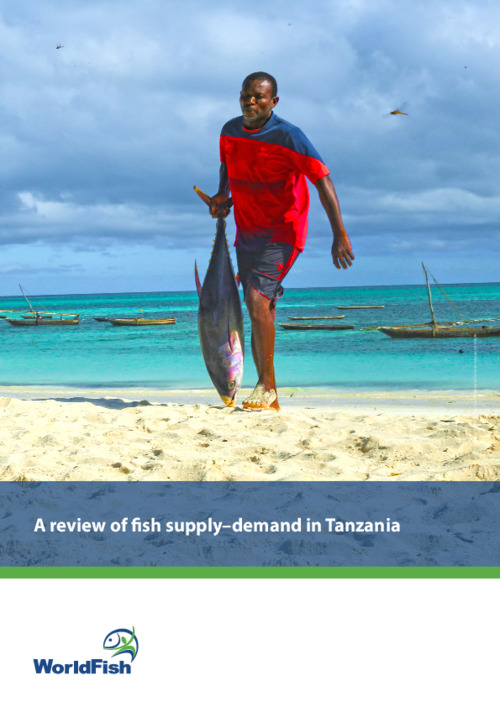Please use this identifier to cite or link to this item:
https://hdl.handle.net/20.500.12348/5115
A Review of Fish Supply–Demand in Tanzania
| dc.creator | Peart, J. | en_US |
| dc.creator | Tran, N. | en_US |
| dc.creator | Chan, C. | en_US |
| dc.creator | Maskaeva, A. | en_US |
| dc.creator | Shoko, A.P. | en_US |
| dc.creator | Kimirei, I.A. | en_US |
| dc.creator | Madalla, N. | en_US |
| dc.date.accessioned | 2022-03-17T04:10:43Z | |
| dc.date.available | 2022-03-17T04:10:43Z | |
| dc.date.issued | 2021 | en_US |
| dc.identifier.citation | Peart J, Tran N, Chan CY, Maskaeva A, Shoko AP, Kimirei IA and Madalla NA. 2021. A review of fish supply–demand in Tanzania. Penang, Malaysia: WorldFish. Program Report: 2021-32. | en_US |
| dc.identifier.uri | https://hdl.handle.net/20.500.12348/5115 | |
| dc.description.abstract | As part of WorldFish’s analysis of fisheries and aquaculture futures in Tanzania, this document serves as a preliminary review of the data and existing literature to help further develop a fish sector model for the country. We highlight factors influencing fish supply and demand in Tanzania and the need for further research, investment and sustainable management of aquatic food systems in the country. Total fishery output in Tanzania has been relatively stable since the mid-1990s. Although this trend has been seen in capture fisheries throughout the world, other countries have been able to make substantial increases in fish supply by advancing aquaculture. Recently, Tanzania has started to implement several initiatives aiming to promote aquaculture development. Several factors are inhibiting the growth of the country’s fish supply. Post-harvest infrastructure is insufficient, and coordination of fish supply chains is poor. Furthermore, there is a paucity of knowledge regarding fishstock dynamics that may lead to inefficient management. Above all, however, the current low production rate of the aquaculture subsector is limiting growth. Tanzania has also yet to design and implement an effective management strategy or conduct extensive industrial marine fishing operations in its exclusive economic zone (EEZ), and address issues of overexploitation of the fishery. Furthermore, post-harvest handling losses are significant, leading to an estimated 40% loss in fish yields. Fish is a vital supplier of essential micronutrients for developing countries, but per capita consumption of 8.5 kg in Tanzania is well below the global average (20.5 kg), which may have negative effects on the development of healthy livelihoods and food security. This trend is not expected to subside in the near future given the anticipated high population growth, economic growth and changing consumer habits, which are the main driving forces behind increasing fish demand. Without substantial increases in fish availability, Tanzania can expect further decreases in per capita fish consumption in the future. In the final section of this report, we outline steps that can be taken to address sustainable management and availability of aquatic resources in the future, including an in-depth fish sector analysis. We recommend foresight modeling of the different alternative scenarios that represent the most likely occurrences given the findings of this review. Through foresight analysis, projected costs and benefits of these scenarios can be considered to ensure that management decisions are made with the highest degree of certainty and efficiency. Governance and policy decisions that will be made soon are vital to the efficiency of aquatic food production in Tanzania and ensuring the economic, social and environmental contributions that they can provide. | en_US |
| dc.format | en_US | |
| dc.language | en | en_US |
| dc.publisher | WorldFish (WF) | en_US |
| dc.rights | CC-BY-NC-4.0 | en_US |
| dc.subject | no poverty | en_US |
| dc.subject | zero hunger | en_US |
| dc.subject | life below water | en_US |
| dc.subject | fish demand | en_US |
| dc.subject | fish supply | en_US |
| dc.subject | Fish | en_US |
| dc.title | A Review of Fish Supply–Demand in Tanzania | en_US |
| dc.type | Working Paper | en_US |
| cg.contributor.crp | Livestock | en_US |
| cg.contributor.crp | Fish | en_US |
| cg.contributor.funder | International Livestock Research Institute | en_US |
| cg.contributor.project | ILRI multi-year integrated partnership POLICIES project linked to the CRP on livestock | en_US |
| cg.coverage.country | United Republic of Tanzania | en_US |
| cg.coverage.region | Eastern Africa | en_US |
| cg.subject.agrovoc | nutrition | en_US |
| cg.subject.agrovoc | supply and demand | en_US |
| cg.subject.agrovoc | fish trade | en_US |
| cg.contributor.affiliation | WorldFish | en_US |
| cg.contributor.affiliation | The University of Dodoma | en_US |
| cg.contributor.affiliation | Tanzania Fisheries Research Institute | en_US |
| cg.contributor.affiliation | Sokoine University of Agriculture | en_US |
| cg.identifier.status | Open access | en_US |
| cg.contribution.worldfishauthor | Peart, J. | en_US |
| cg.contribution.worldfishauthor | Tran, N. | en_US |
| cg.contribution.worldfishauthor | Chan, C. | en_US |
| cg.description.theme | Value chains and nutrition | en_US |
| cg.creator.id | Nhuong Tran: 0000-0002-1813-4571 | en_US |
| cg.creator.id | Chin Yee Chan: 0000-0001-8615-2678 | en_US |
